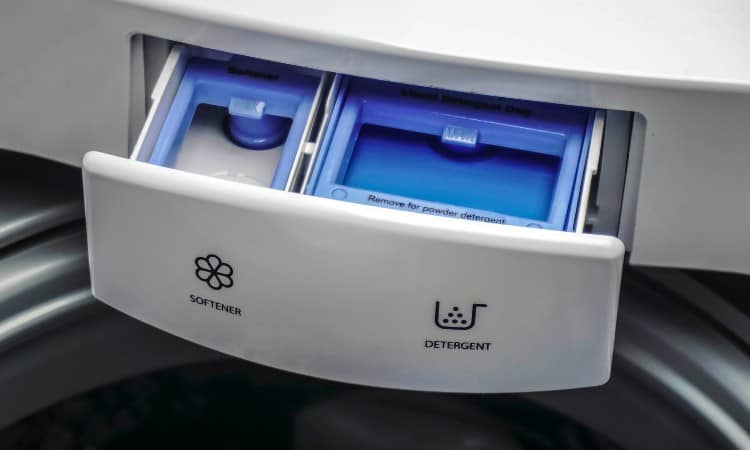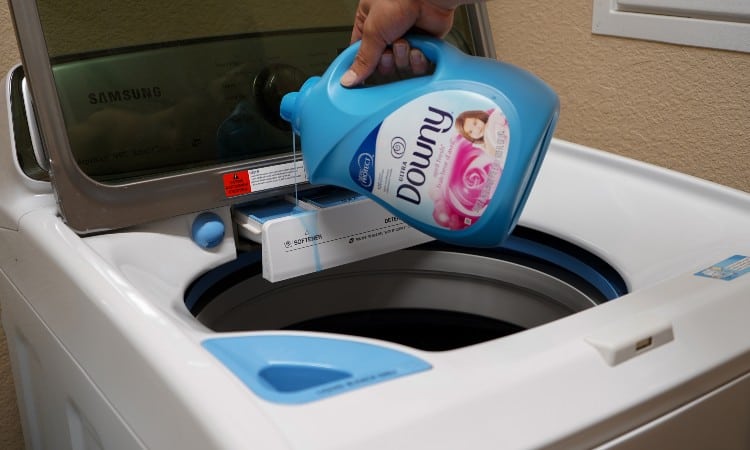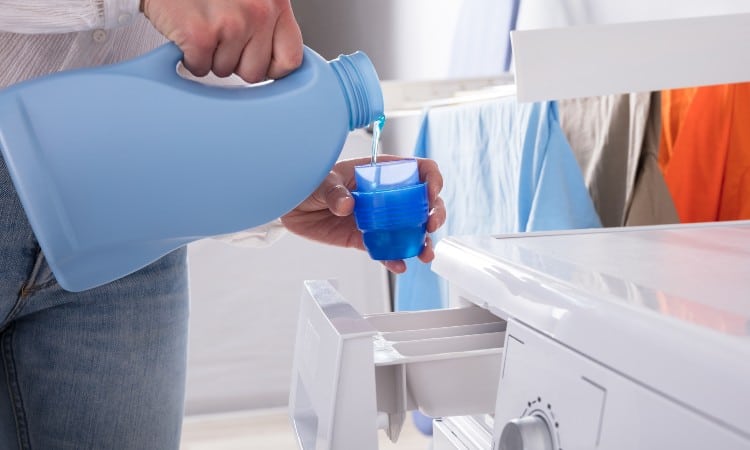Have you ever stood in the laundry aisle and wondered what product you should be buying? Do you need a detergent or a fabric softener? What do they do? When it comes to the choice between fabric softener vs detergent, what is the difference?
Fabric softener and detergent perform two different roles in the laundry room. Detergent cleans clothing. It removes stains and odors from clothes using a mix of chemicals and enzymes. Fabric softener, or conditioner, softens and protects the fibers in clothes. It cannot clean clothing as it does not contain cleaning agents.
Fabric softener and detergent are a winning combination when it comes to laundry. They work together to keep your clothes clean and smelling fresh. Let’s take a closer look at the differences between the two and when you should be using them.

Fabric Softener vs Detergent: What’s the Difference?
Detergent and fabric softeners are both products used in the laundry room. They each perform a separate function or role. A fabric softener conditions clothing, bedding, and washable drapes. In comparison, a detergent cleans and removes odors and stains from washable fabric items.
Although they are both used in the washing process, they can’t be interchanged. A softener can’t be used to clean clothes. Unless a detergent has an added fabric softener in it, it can’t be used to condition clothing or other fabric items.
Only a washing detergent is a necessary part of the laundry process. Fabric softeners are good to have but not essential. You can’t wash any fabric without a detergent to eat away the dirt, grime, and smells. But, you don’t always need a softener. Some washing instructions stipulate softeners should be avoided for some materials.
What Is Fabric Softener?

Fabric softener is used to take the coarseness out of fabric. It can be added to a wash when it is on the rinse cycle to soften clothes and make them smell fresh and clean.
Sometimes when clothing is washed, the build-up of friction caused by the washing process damages the fibers in the material. As the fabric rubs together, it becomes rough and stiff. Adding softener smooths out the fibers making them soft and more comfortable against the skin.
Also known as fabric conditioner, the softener protects the fibers by reducing friction. Instead of rubbing against each other, the silky softness of the conditioner allows them to glide side by side. The less harsh contact during a washing cycle, the less damage is caused. Thus, clothing lasts longer.
Not only does softener protect from washing damage, but it also prevents fading. Colors are protected for longer due to the fibers in the fabric remaining soft and malleable. This softness allows the fibers to retain their absorption levels and hold on to the color.
Another benefit of using fabric softeners is the addition of fragrance. Although you can buy fragrance-free softeners, many infuse your laundry with the delicate aromas of sea breeze, pine meadows, or wooded valleys. This fragrance can last for days, even when the clothing is back in the closet. Leaving your laundry and your home smelling fresh, relaxing, and clean.
Key Ingredients
The main ingredients in fabric softeners enable the product to perform its task. Let’s take a look at the essential ones.
Conditioning Agent
A conditioning agent is a combination of oils and lubricants that coat the surface of the item to be conditioned. In this case, fabric. The substance has an in-built positive charge that is attractive to the negative elements within the fabric fibers.
Positive conditioning agent bonds to the negative fibers and neutralizes them. This reduces the possibility of an electrical build-up caused by friction. When it comes to material, this electrical activity is known as static. With less static formed during the washing cycle, there will be less static cling in your clothes.
Emulsifiers
An emulsifier is a substance that encourages one liquid to be held within another. For instance, oil can be suspended in water to create a salad dressing.
Fabric softeners can contain three different types of emulsifiers. Micro-emulsions, macro-emulsions, and emulsion polymers. Each one has a different effect on the conditioning agent.
Micro and macro emulsifiers make the conditioning agent particles smaller or larger. Smaller particles get absorbed directly into the clothes. Larger particles disperse into the water, which then soaks the clothes. An emulsion polymer creates a net of particles that coat the surface of the clothing.
Regardless of which emulsifier your fabric softener contains, the result with all three types is the same. They bind the conditioning agent to the fabric.
Preservatives
As with most products containing preservatives, this is a substance with only one goal. It preserves the life of the product.
Fabric softeners can sit on a store shelf for a few days or weeks, depending on demand. Even when purchased, not all the softener is used straight away. One fabric conditioner bottle can last for several washes.
To ensure the quality of the product remains constant, preservatives are added. This ensures all softeners perform equally well. Regardless of how long they have been on the shelf.
Fragrances
There’s nothing more comforting than washing that looks and smells clean. Fabric conditioners contain fragrance to eliminate nasty odors left over from the washing cycle. You can also get fragrance-free options.
Pros and Cons of Fabric Softener
| Pros | Cons |
|
|
What Is Laundry Detergent?

Laundry detergent is a cleaning agent for cleaning clothes and other washable household fabrics. Available in either liquid or powder formats, the product lifts dirt, stains, and odors out of items made from the material.
Historically, washing powder used to be a mix of animal fat and lye, otherwise known as soap and caustic soda. The 1950s saw the advent of synthetic detergents like the ones we know today. It was the 1970s that revolutionized detergent with the introduction of enzymes specific to certain stains and odors. Washing powders and liquids have never looked back.
A mixture of chemicals and enzymes, laundry detergent, can also protect colors and make white clothing brighter. Both colors and white fabrics can suffer from repeated washing. Whites, in particular, can become dull. Detergents also contain fluorescent whiteners and brighteners to help eliminate or at least reduce this kind of damage.
There are several brands of detergent on the market. Each brand has a unique formula making the detergents react differently. Some are better for delicate clothing and others are heavy-duty detergents suitable for the toughest stains.
Key Ingredients
Alkalies
Found in most laundry detergents, alkalies are soluble salts that react with acids to neutralize them. Because of this, they remove dirt and stains without the need to rub. Common alkalies found in washing detergent include caustic soda and potassium hydroxide.
Other alkalies known for their cleaning properties are baking soda and borax. It’s the alkaline content of the detergent that causes clothes to feel rough after washing.
Sulfates or Surfactants
A sulfate is a salt formed during a reaction between sulfuric acid and another chemical. It’s a cleaning agent found in shampoos and detergents. A surfactant, or surface-active agent, reduces the surface tension of a liquid, helping it to spread. Sulfates are a type of surfactant.
They work by attracting dirt and water to opposite ends of the surfactant. As the washing machine agitates the clothing, the surfactant grabs the dirt molecule and drags it into the water. The water-friendly end of the sulfate keeps it there, so it is rinsed away.
Catalytic Enzymes
Enzymes are naturally occurring waste-disposal units. Usually found in our stomachs as part of the digestive system, they break down food particles. Equally effective in detergent, similar enzymes go to battle in our washing machines to speed up the removal and decomposition of dirt.
There are different types of enzymes breaking down different substances. You have proteases to dispose of proteins, lipases to get rid of fats, and amylases to fend away starch. All the enzymes group together to ensure you get a clean wash.
pH Modifiers, Preservatives, and Water Conditioners
As with softeners, detergent needs preservatives. Enzymes are biological organisms and have a shelf-life. Adding preservatives keeps them effective for longer.
Water conditioners and pH modifiers help counteract the effects of adding alkalies to the wash. They help soften the water. By restoring the pH balance, clothing is protected from damage from hard water.
Will Fabric Softener Clean Clothes?
Fabric softener won’t clean clothes. Softener is designed to soften and condition clothing. It does not contain enzymes or the chemicals required to lift dirt and stains from the material. Only using softener will make your wash soft, but it will be dull and still dirty.
It’s a bit like shampoo and conditioner for hair. Shampoo cleans your hair and the conditioner makes it manageable and soft to the touch. Using conditioner on its own leaves hair flat and listless.
When to Use Fabric Softener?
Fabric softener should be added to the rinse part of your wash cycle. The reason being, the enzymes in the washing detergent will remove the conditioner if it’s added any sooner. By the time the rinse cycle has started, most of the detergent has drained away.
Some washing machines have a pull-out or lift-up tray with compartments for washing detergent and fabric conditioner. Each compartment is marked to indicate what liquid or powder should go in each. The compartment for fabric softener holds on to the liquid until the wash cycle reaches the final rinse.
Fabric softener is best used on cotton, wool, and linen fabrics. Natural fibers are the ones most likely to become rough following a dip in the washing machine.
When Shouldn’t You Use Fabric Softener?
Some fabrics shouldn’t come into contact with any type of fabric softener. Whether it’s a stand-alone brand or a detergent-softener combination, avoid both if you are washing any of the following materials.
Microfiber Material
Microfiber fabric is designed to grab dust, dirt, and moisture. To do so it has lots of tiny little spaces that latch on to particles and lock them into the fabric. Adding softener to microfiber clogs up the little holes preventing the fabric from doing its job.
Fleece or Other Fluffy Fabrics
You’d think fleece and other fluffy fabrics would love to bathe in fabric softener after a grueling wash cycle. The truth is, softener attaches to fibers and can drag them down. This can mean your soft, comfy fleece or fluffy sweatshirt becomes hard and rough. Steer clear of all fabric conditioners to ensure your fleece stays fluffed up.
Moisture-Wicking Fabrics (Sportswear)
Similarly to microfiber fabrics, moisture-wicking clothing has tiny little gaps between the fibers that allow moisture to evaporate. Fabric softener gums up the gaps and will prevent moisture from escaping. Not good for the fabric or you as moisture will remain close to your skin.
Baby Clothes
Baby clothing needs to be kept well away from fabric softeners or conditioners for two reasons. Firstly, babies can have sensitive skin, which can be irritated by the chemicals in the softener. The second reason, baby clothing is treated so it can be flame resistant. Fabric conditioners will strip the flame retardant coating, making the clothing less safe.
Towels
The famous riddle, what gets wet as it dries, sums up a towel to a tee. They need to be super absorbent to make sure our skin gets as dry as possible. Softeners cover the surface of the towel fabric, causing it to become less able to soak up moisture. It may be nice and soft, but you’re going to stay wet.
Using Fabric Softener Directly on Fabric
Regardless of the type of fabric, you are washing, never apply softeners to any material directly. This will damage the fibers and cause stains. Fabric softener must always be diluted before it comes into contact with the fabric.
Can You Mix Laundry Detergent With Fabric Softener?
Laundry detergent and softener can be purchased as a two-in-one product. Either in liquid form or as a pod, the detergent with softener will be released automatically at the right point in the cycle. They are kept apart by a dissolvable membrane. A separate fabric softener can’t be added to detergent at home. The detergent would prevent it from working.
Separate detergent and fabric softener need to be kept apart. A washing machine has a dispenser drawer with different compartments for each product. The dispenser will release both products individually when the wash cycle has reached the right part.
Can Fabric Softener Be Used as Detergent?
Fabric softener does not contain cleaning agents or enzymes to dissolve dirt and stains. It can’t be used in place of a detergent. A fabric softener, or conditioner, can only be used to soften the fibers in clothing and add a fresh-smelling fragrance.
The combination of enzymes and chemicals in detergent attack different stains and odors by breaking them down, so they dissolve into the wash water. Fabric softeners are unable to do that.
I Used Fabric Softener Instead of Detergent, What Now?
Fabric softener won’t damage clothing if it has been added to the wash at the wrong time. Allow the wash to continue until the end and remove the clothing. Re-wash the items on a new wash cycle using detergent. The detergent will remove the softener without any detriment to the clothing.
You can re-add the fabric conditioner for the final rinse cycle. Although you will have wasted a bit of softener, your clothes will be perfectly fine.
What to Use Instead of Fabric Softener?
There are several ways you can soften clothes without using a fabric softener. Adding baking soda to the wash can soften fabric fibers. You can also soften them in a dryer by using wool drying balls. Adding a little vinegar to the final rinse can help dissolve residue build-up leading to softer fabrics.
Putting a clean, dry towel in the dryer with a load of laundry can reduce static and helps spread air between the garments. A piece of aluminum foil can do the same job as can a tennis ball.
Alternatives to Laundry Detergent
There are several alternatives to laundry detergent. All of them are effective and worth a try. Soap flakes were one of the original laundry products before detergent was invented. Borax and baking soda are two more general household items adept at cleaning clothes and fabrics.
A couple of products to keep away from your laundry are washing up liquid, hair shampoo, and hair conditioner. None are designed for fabric and can cause damage through staining, color removal, or greasy spots.
Laundry Detergent + Fabric Softener Combos
To make life easier and to cut down on the number of products in the laundry room, you can get laundry detergent with added fabric softener. Designed to release detergent and softener at just the right time in the wash, a combination pack could be the ideal choice for your laundry.
Tide Pods 4-In-1 With Downy
 Two of the top brands in detergent and fabric softener are combined to create Tide Pods 4-In-1. The Combo pack includes detergent, stain remover, brightener, and Downy Fabric Protect. All in one handy package.
Two of the top brands in detergent and fabric softener are combined to create Tide Pods 4-In-1. The Combo pack includes detergent, stain remover, brightener, and Downy Fabric Protect. All in one handy package.
With an innovative design, the pods separate the key ingredients until it’s their time to join the wash. Ensuring maximum cleaning power and fabric protection right up to the final rinse.
Arm & Hammer Plus Softener
 Combine the powerful cleaning of Arm & Hammer with the gentle touch of softener for clean, fresh clothing. Ideal for both standard and High-Efficiency washing machines, the baking soda and conditioning partnership packs a devastating blow to the toughest dirt in your laundry.
Combine the powerful cleaning of Arm & Hammer with the gentle touch of softener for clean, fresh clothing. Ideal for both standard and High-Efficiency washing machines, the baking soda and conditioning partnership packs a devastating blow to the toughest dirt in your laundry.
Contained in one handy-sized bottle, you’ll always get the perfect mix of detergent and softener for every wash. With less waste and no guesswork, this is a winning combination for a successful laundry day.
What Happens If You Use Fabric Softener When It Says Not To?
Fabric softener can damage some material. It can strip the special finish from fabrics and cause others not to perform as they should. To remove the fabric softener, rewash the clothing with detergent. The detergent will remove the softener. Make sure the water level completely covers the item.
You may find you need to wash the clothing a few times before all the conditioner is gone. Unfortunately, the garment properties may never be as effective again. The best way to avoid accidentally adding softener is don’t use it for any garment. Use alternative methods for getting clothing soft and smelling fresh.
What Is the Difference Between Fabric Softener and Fabric Conditioner?
There is no difference between softeners and conditioners. The two terms mean the same thing and are interchangeable. Some manufacturers use one term and others use another. It’s down to branding.
Another reason for the different terms could be due to where the products are made. Fabric softeners are known as fabric conditioners in the United Kingdom. Whereas they tend to be called softeners in the United States.
Conclusion
The difference between fabric softener and detergent is the job they do. That laundry aisle at the local store should feel less daunting now! I hope this article has helped you gain more confidence with your wash.